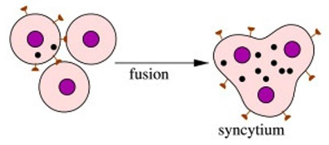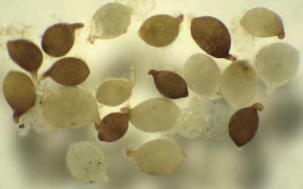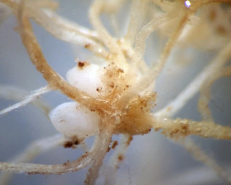🪱 Cyst Nematodes
Species, Biology, Symptoms, Integrated Management
Which of the following is wrong regarding cyst nematodes?
- The cyst nematodes comprise a group of different genera but only
HeteroderaandGloboderaare economically important in India. - Both genus both have unique character of retention eggs & larvae within mature female body which turn into brown or black hard body after its death; that is why known as cysts.
- Heteros means different and deras means skin/body wall i.e., different types of body wall i.e., hard brown cyst wall as compared to soft, transparent body wall of other nematodes.
- Globus means globe, rounded and deras means body wall. Means rounded shape of cysts.
- The name cyst nematode is assigned at generic level to all those nematodes in which the body wall of the female turns into a hard brown cyst enclosing egg inside. And as the cyst nematodes are very host specific, they are generally named after their hosts at the specific level.
- Cereal Cyst Nematode: Heterodera avenae
- Soybean Cyst Nematode: Heterodera glycines (it causes yellow dwarf disease in soybean)
- Sugarbeet Cyst Nematode: Heterodera sechati (first discovered cyst nematode)
- Pigeon Pea Cyst Nematode: Heterodera cajani also infests other pulses.
- Paddy Cyst Nematode: Heterodera oryzicola (serious pests of rice in Kerala, Orissa, Haryana in upland rice growing areas).
- Maize/Corn Cyst Nematode: Heterodera zeae
- Clover Cyst Nematode: Heterodera trifolii
- Brassica Cyst Nematode: Heterodera cruciferae
Life Cycle
- Cyst nematodes are sedentary endoparasites. Second stages (J2) larvae usually penetrate the root just behind the growing point. These larvae grow rapidly and thee moults occur in the host. In about 5 – 6 weeks after penetration, the white cysts are clearly visible which protrude from the root surface. These young cysts are packed with eggs and upon death the body wall hardens due to quinone tanning into a tough resistant brown covering known as cysts. The cysts get separated from the root and fall into soil.
- Larval emergence from cysts is often in response to root exudates from a host plant. The best emergence of juveniles occurs as a result of a rise in temperature after a period of low temperature. Maximum emergence of larvae from cysts under Indian condition takes place at a temperature of 20 - 22°C. The cysts continue to release eggs over a period of 3 – 4 years at the rate of 50 per cent viable eggs per year. There is only one generation of the nematode in a year.
- Multiplication of nematode is favoured by soil texture. Migration of second stage juveniles is favoured by light textured soils. The host cells close to the head region of the sedentary female being to modify and finally enlarge to form multinucleate
syncytiumwith a thick outer boundary. The female feeds from this nurse cell system and grows. The swollen adult female protrudes out of the root tissues and later changes into brown cysts. - Although cyst nematodes induce giant cell formation, gall formation is not distinct. Each syncytium is associated with only one nematode in the case of cyst nematodes unlike the root – knot nematodes where one or more nematodes are associated with a syncytium.

- Nuclei is enlarged in the syncytium caused by the root – knot nematode but in cyst nematode nuclei is relatively small. The syncytia are bound by the vascular elements especially xylem which develops specific wall in growth. There is enlarged nucleoli and irregular nuclei. Abundant mitochondria, golgi bodies, protoplasts and dense endoplasmic reticulum are also found in the syncytia

Life-Cycle of Heterodera avena
Heterodera avende
- Female is lemon shaped.

- Wheat and barley are the main hosts of H. avenae in India.
- In Rajasthan and Haryana, it is known to cause “Molya” disease in wheat and barley.
Symptoms
- Above Ground: Patches of stunted plant growth and chlorosis appear when the crop is about 1-2 months old.

- Below Ground
- Roots become typically bushy with slight swellings marking the sites of nematode infection.

- Appearance of white glistening females on the roots during January/February is confirmation of nematode infection.

- Roots become typically bushy with slight swellings marking the sites of nematode infection.
Management
- As stated earlier that it is very host specific, crop rotation with mustard or gram is most effective control.
- Early sowing escape to damage.
- Carbofuran @2kg a.i. per ha.
- Deep ploughing is destroyed quiescent eggs of nematodes.
- Grow resistant varieties:
- Wheat:
Raj MR-1 - Barley: RD 2052, RD-2035 and
Rajkiran.
- Wheat:
Globodera rostochiensis
- In India, potato cyst nematode was first recorded in 1961 by Jones from Nilgiri Hills of Tamil Nadu.
- Whitish/creamish or yellow/golden Female which is spherical shaped.

Symptoms
- Foliage shows wilting symptoms, root system poorly developed and tuber formation is drastically reduced in number and size.
- Spherical white females of the size of pin-head can easily be observed on the roots of infected plants which can be easily uprooted.

Management
- Legislative methods: Domestic quarantine was introduced under the destructive Insect Pests Act in 1971 against Globodera sp., whereby the movement of potato tubers from infested areas of Nilgiri hills to other areas is banned. Produce from Nilgiri areas cannot be used as seed for other areas and the produce is procured only by Nilgiri Cooperative Society.
- Resistant variety:
Kufri swarnais most resistant to Globodera sp. and released for cultivation in Nilgiri hills in 1985, where it covers up to 40% area under potato cultivation.
References
- Dropkin, V.H. 1980. Introduction to plant nematology. John Wiley and sons, INC. New York.
- Singh, R.S and Sitaramaiah, K. 1994. Plant pathogens. The plant parasitic nematodes. Oxford & IBH Pub. Co. Pvt. Ltd. New Delhi.
- Parvata Reddy, P. 1983. Plant nematology. Agricole Pub. Co., New Delhi.
- Southey, J. F. Laboratory methods for work with plant and soil nematodes Tech.
- Bull. Min. Agric. Fish. Food. Her Majesty’s Stationary Office, London.
- Walia, R. K and Bajaj, H. K (2014). Textbook of Introductory Plant Nematology. Directorate of Knowledge Management in Agriculture, ICAR, New Delhi.
- Kumar, V., Khan, M.R. & Walia, R.K. Crop Loss Estimations due to Plant-Parasitic Nematodes in Major Crops in India. Natl. Acad. Sci. Lett. 43, 409–412 (2020). https://doi.org/10.1007/s40009-020-00895-2
- Figure 1: Source: A: Maggenti, 1981, B-E: Franklin, 1973
Which of the following is wrong regarding cyst nematodes?
- The cyst nematodes comprise a group of different genera but only
HeteroderaandGloboderaare economically important in India. - Both genus both have unique character of retention eggs & larvae within mature female body which turn into brown or black hard body after its death; that is why known as cysts.
- Heteros means different and deras means skin/body wall i.e., different types of body wall i.e., hard brown cyst wall as compared to soft, transparent body wall of other nematodes.
- Globus means globe, rounded and deras means body wall. Means rounded shape of cysts.
- The name cyst nematode is assigned at generic level to all those nematodes in which the body wall of the female turns into a hard brown cyst enclosing egg inside. …
Become Successful With AgriDots
Learn the essential skills for getting a seat in the Exam with
🦄 You are a pro member!
Only use this page if purchasing a gift or enterprise account
Plan
Rs
- Unlimited access to PRO courses
- Quizzes with hand-picked meme prizes
- Invite to private Discord chat
- Free Sticker emailed
Lifetime
Rs
1,499
once
- All PRO-tier benefits
- Single payment, lifetime access
- 4,200 bonus xp points
- Next Level
T-shirt shipped worldwide

Yo! You just found a 20% discount using 👉 EASTEREGG

High-quality fitted cotton shirt produced by Next Level Apparel